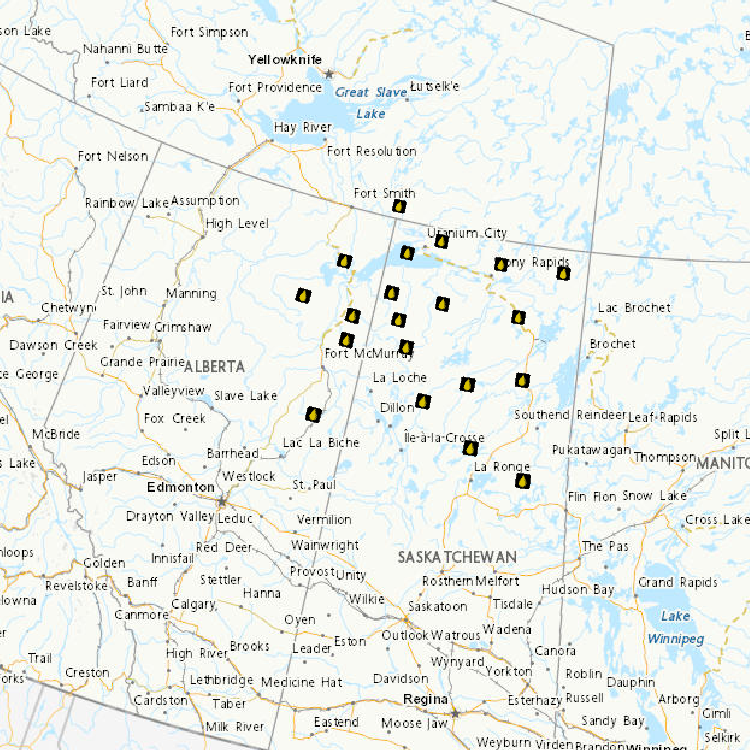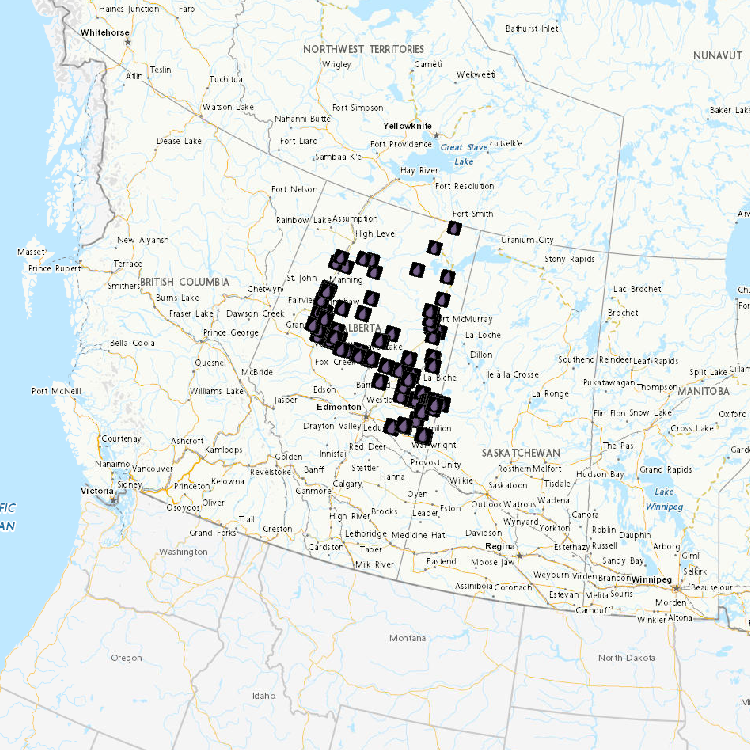1.3.2. Ecosystem Assessment and Approaches
Type of resources
Topics
Keywords
Contact for the resource
Provided by
Formats
Representation types
Update frequencies
status
-

Air emissions from oil sands development can come from a number of sources including industrial smokestacks, tailings ponds, transportation, and dust from mining operations. Air quality monitoring under the Joint Canada-Alberta Implementation Plan for the Oil Sands is designed to determine the contribution of emissions from oil sands activities to local and regional air quality and atmospheric deposition both now and in the future. Ambient air quality data include: - Filter Pack (24-hour integrated concentrations of particle-bound SO2-4, NO-3, Cl-, NH+4, Ca2+, Mg2+, Na+, K+ and gaseous SO2 and HNO3 collected daily by the Canadian Air and Precipitation Monitoring Network) - Total Gaseous Mercury (hourly mixing ratios measured by the Canadian Air and Precipitation Monitoring Network and Prairie and Northern Region) - Atmospheric speciated mercury (Hg) (2-hour average concentrations of gaseous elemental Hg (GEM), reactive gaseous Hg (RGM), and Hg on PM2.5 (total particulate Hg - TPM) - Comprehensive set of measurements collected from an aircraft (various time resolutions) covering an area of 140,000 km2 over the oil sands region - Comprehensive set of measurements collected from the Fort McKay Oski-ôtin monitoring site - Ozone (hourly mixing ratios measured by the Canadian Air and Precipitation Monitoring Network) - Ozone Vertical Profiles (ozone mixing ratios as a function of height) measured by the Canadian Ozone Sonde Network - Aerosol Optical Depth (measure of the degree to which the presence of aerosols in the atmosphere prevents the transmission of light, from the ground to the top of the atmosphere) measured as part of the AErosol RObotic CANadian (AEROCAN) network - Satellite overpass data have a relatively high spatial resolution over the Oil Sands region to produce images and geo-referenced data of nitrogen dioxide (NO2) and sulphur dioxide (SO2) “vertical column density” (which correlates with surface concentration)
-

Air emissions from oil sands development can come from a number of sources including industrial smokestacks, tailings ponds, transportation, and dust from mining operations. Air quality monitoring under the Joint Canada-Alberta Implementation Plan for the Oil Sands is designed to determine the contribution of emissions from oil sands activities to local and regional air quality and atmospheric deposition both now and in the future. Deposition data include: - Passive Sampling of PACs deployed for two month periods across a network of 17 sites - Active sampling of PACs at three sites to inform the amount of dry deposition - Particulate metals (24 hour integrated samples following the one in six day National Air Pollution Surveillance (NAPS) cycle)
-

Plant health assessments and vegetation surveys are undertaken at both terrestrial and wetland sites in the oil sands region and in reference areas. Plant monitoring is being conducted for biodiversity and contaminants, and because plants are important both as wildlife habitat and as traditional-use species. Plant and soil samples are collected at monitoring sites near and at varying distances from oil sands operations. Plant tissues are being examined for levels of naphthenic acids (NAs), polycyclic aromatic hydrocarbons (PAHs) and heavy metals. Plant indicator species include Vaccinium spp. (blueberry), Ledum groenlandicum (Labrador tea), Arctostaphyllos uva-ursi (common bearberry), and Cornus canadensis (bunchberry). Soil samples from riparian banks and boreal forest locations are also collected for greenhouse studies. These experiments evaluate the uptake, distribution, and toxicity of the contaminants in plant tissue.
-
Assess the importance of atmospheric deposition of contaminants as a contributor to ecological impacts of oil sands development and identify sources. • Use snowpack measurements sampled across a gridwork to develop maps of winter-time atmospheric contaminant loadings for the region ~100 km from the major upgrading facilities • Assess long-term trends in winter-time atmospheric deposition • Determine the potential impact of wintertime snowpack mercury loads on tributary river water mercury concentrations (Spring Freshet) using Geographic Information System and hydrological modelling approaches • Compare snowpack loadings to those obtained from precipitation monitoring and compare spatial patterns to PAC air measurements obtained from passive sampling network
-

The objectives of the fish component of the integrated oil sands monitoring program are to provide the necessary data/information to address key questions related to both environmental health of fish populations and fish health issues that can be used to inform human use and consumption. The questions underlying the fish monitoring design are related to the status and health of wild fish populations in the Lower Athabasca River including and in an expanded geographical extent. Data is being collected to provide a baseline against which future changes in fish populations will be evaluated, and compared to data from historical studies to assess change over time to the current state. Data is also being collected in areas of new oil sands development, to develop baseline data for future site-specific comparisons, contribute to an expanded geographic basis of the overall monitoring plan, and contribute to an improved ability to examine cumulative effects.
-

Acid-Sensitive Lakes Nine hundred and thirty-three lakes located in Saskatchewan, Alberta and the Northwest Territories were sampled to establish current acidification status. Of the 933 lakes, 244 (or 26%) are considered acid sensitive, almost always because of naturally low calcium and magnesium (or "base cation") concentrations. The most acid-sensitive lakes (i.e., those with extremely low base cation concentrations) are located on the Canadian Shield in both Alberta and Saskatchewan and east of the oils sands development area. Fifty-one of the 244 acid-sensitive lakes were sampled twice annually (spring and fall) to identify chemical changes through trend analyses. Results revealed that 55% of these lakes had concentrations of some metals in excess of Canadian Council of Ministers of the Environment guidelines. Of the 291 samples taken in the 51 lakes, iron concentrations were greater than guidelines in 36% (105 samples), aluminum in 33% (97 samples), lead in 0.3% (1 sample) and copper in 0.3% (1 sample). The metals in these lakes occur naturally and are expected to be found in a wide range of concentrations given the geology and physiography of the Canadian Shield. It remains to establish the relationship between acid sensitivity, geology and high metal concentrations.
-

Water level and discharge data are available from Water Survey of Canada’s Hydrometric Network. The Water Survey of Canada (WSC) is the national authority responsible for the collection, interpretation and dissemination of standardized water resource data and information in Canada. In partnership with the provinces, territories and other agencies, WSC operates over 2500 active hydrometric gauges across the country, maintains an archive of historical information for over 7600 stations and provides access to near real-time (water level and stream flow) provisional data at over 1700 locations in Canada.
-

Waterfowl and mammals harvested and trapped at various locations in the oil sands region and in reference locations are assessed for contaminant burdens and toxicology. Wildlife samples are obtained from local hunters and trappers. Tissue samples are analysed for concentrations of oil sands-related contaminants (heavy metals, polycyclic aromatic hydrocarbons, and naphthenic acids). Dead and moribund birds collected from tailing ponds are also evaluated for levels and effects of contaminants.
-

The surface water quality (WQ) program, as part of the Joint Canada/Alberta Implementation Plan, is designed to improve the ability to detect change and predict effects in relation to point and non‐point sources. A mass‐balance approach has been used for assessing the quantity, movement, and cycling of materials in the watershed. Applying this approach required a sampling program which included quantification of the sources, transport, flux, and fate of materials and contaminants. The Surface WQ monitoring sampling includes, in part, collection of; - event (freshet and rain) based WQ samples in tributaries ranging from daily to bi-weekly, - WQ samples in the Athabasca River using cross-channel transect methods at specified Phase 1 sites, - enhanced (additional parameters) WQ sampling at M9, M12, and M11A and at 5 new interconnecting channel stations within the Expanded Geographical Area (EGA), - ground water samples in specific high priority tributaries, and - auto-monitoring (near real-time) on a subset of parameters at sites in the EGA
-

Monitoring activities have collected bulk suspended sediment samples using continuous flow centrifuges and Phillips Tube samplers in the Lower Athabasca River and tributaries respectively. Further, in the absence of pre-development monitoring for this region, high fidelity dated lake sediment cores were used to assess the natural range in contaminant deposition to this region and to obtain a historical perspective of contaminant loadings. All sediments (suspended river and lake cores) have been analyzed in the laboratory for sediment quality variables as per Appendix B in the Integrated Monitoring Plan (cores were also analyzed for paleo indicators of ecosystem health such as diatoms). In addition, as the Lower Athabasca river bed sediments are known to shift and migrate downstream, bathymetric maps of the bed-channel morphology over time was also completed. This will allow for estimates of bed sediment transport downstream for the period of survey, and be useful in calibration/validation of sediment and contaminant numerical transport models.
 Arctic SDI catalogue
Arctic SDI catalogue